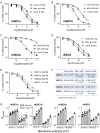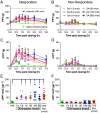Inhibition of acid-sensing ion channels by diminazene and APETx2 evoke partial and highly variable antihyperalgesia in a rat model of inflammatory pain
- PMID: 29134638
- PMCID: PMC5980509
- DOI: 10.1111/bph.14089
Inhibition of acid-sensing ion channels by diminazene and APETx2 evoke partial and highly variable antihyperalgesia in a rat model of inflammatory pain
Abstract
Background and purpose: Acid-sensing ion channels (ASICs) are primary acid sensors in mammals, with the ASIC1b and ASIC3 subtypes being involved in peripheral nociception. The antiprotozoal drug diminazene is a moderately potent ASIC inhibitor, but its analgesic activity has not been assessed.
Experimental approach: We determined the ASIC subtype selectivity of diminazene and the mechanism by which it inhibits ASICs using voltage-clamp electrophysiology of Xenopus oocytes expressing ASICs 1-3. Its peripheral analgesic activity was then assessed relative to APETx2, an ASIC3 inhibitor, and morphine, in a Freund's complete adjuvant (FCA)-induced rat model of inflammatory pain.
Key results: Diminazene inhibited homomeric rat ASICs with IC50 values of ~200-800 nM, via an open channel and subtype-dependent mechanism. In rats with FCA-induced inflammatory pain in one hindpaw, diminazene and APETx2 evoked more potent peripheral antihyperalgesia than morphine, but the effect was partial for APETx2. APETx2 potentiated rat ASIC1b at concentrations 30-fold to 100-fold higher than the concentration inhibiting ASIC3, which may have implications for its use in in vivo experiments.
Conclusions and implications: Diminazene and APETx2 are moderately potent ASIC inhibitors, both inducing peripheral antihyperalgesia in a rat model of chronic inflammatory pain. APETx2 has a more complex ASIC pharmacology, which must be considered when it is used as a supposedly selective ASIC3 inhibitor in vivo. Our use of outbred rats revealed responders and non-responders when ASIC inhibition was used to alleviate inflammatory pain, which is aligned with the concept of number-needed-to-treat in human clinical studies.
Linked articles: This article is part of a themed section on Recent Advances in Targeting Ion Channels to Treat Chronic Pain. To view the other articles in this section visit http://onlinelibrary.wiley.com/doi/10.1111/bph.v175.12/issuetoc.
© 2017 The British Pharmacological Society.
Figures







Similar articles
-
Analgesic Activity of Acid-Sensing Ion Channel 3 (ASIС3) Inhibitors: Sea Anemones Peptides Ugr9-1 and APETx2 versus Low Molecular Weight Compounds.Mar Drugs. 2018 Dec 12;16(12):500. doi: 10.3390/md16120500. Mar Drugs. 2018. PMID: 30545037 Free PMC article.
-
Reversal of acid-induced and inflammatory pain by the selective ASIC3 inhibitor, APETx2.Br J Pharmacol. 2010 Oct;161(4):950-60. doi: 10.1111/j.1476-5381.2010.00918.x. Br J Pharmacol. 2010. PMID: 20860671 Free PMC article.
-
NS383 Selectively Inhibits Acid-Sensing Ion Channels Containing 1a and 3 Subunits to Reverse Inflammatory and Neuropathic Hyperalgesia in Rats.CNS Neurosci Ther. 2016 Feb;22(2):135-45. doi: 10.1111/cns.12487. Epub 2015 Dec 10. CNS Neurosci Ther. 2016. PMID: 26663905 Free PMC article.
-
A molecular view of the function and pharmacology of acid-sensing ion channels.Pharmacol Res. 2020 Apr;154:104166. doi: 10.1016/j.phrs.2019.02.005. Epub 2019 Feb 5. Pharmacol Res. 2020. PMID: 30731197 Review.
-
Peptides inhibitors of acid-sensing ion channels.Toxicon. 2007 Feb;49(2):271-84. doi: 10.1016/j.toxicon.2006.09.026. Epub 2006 Oct 4. Toxicon. 2007. PMID: 17113616 Review.
Cited by
-
Acid-Sensing Ion Channels and Mechanosensation.Int J Mol Sci. 2021 May 1;22(9):4810. doi: 10.3390/ijms22094810. Int J Mol Sci. 2021. PMID: 34062742 Free PMC article. Review.
-
Pathology and physiology of acid-sensitive ion channels in the bladder.Heliyon. 2024 Sep 17;10(18):e38031. doi: 10.1016/j.heliyon.2024.e38031. eCollection 2024 Sep 30. Heliyon. 2024. PMID: 39347393 Free PMC article. Review.
-
Retinoic Acid-Differentiated Neuroblastoma SH-SY5Y Is an Accessible In Vitro Model to Study Native Human Acid-Sensing Ion Channels 1a (ASIC1a).Biology (Basel). 2022 Jan 20;11(2):167. doi: 10.3390/biology11020167. Biology (Basel). 2022. PMID: 35205034 Free PMC article.
-
PhcrTx2, a New Crab-Paralyzing Peptide Toxin from the Sea Anemone Phymanthus crucifer.Toxins (Basel). 2018 Feb 7;10(2):72. doi: 10.3390/toxins10020072. Toxins (Basel). 2018. PMID: 29414882 Free PMC article.
-
CY-09 Inhibits NLRP3 Inflammasome Activation to Relieve Pain via TRPA1.Comput Math Methods Med. 2021 Aug 14;2021:9806690. doi: 10.1155/2021/9806690. eCollection 2021. Comput Math Methods Med. 2021. Retraction in: Comput Math Methods Med. 2023 Aug 2;2023:9759851. doi: 10.1155/2023/9759851. PMID: 34426748 Free PMC article. Retracted.
References
-
- Akopian AN, Souslova V, England S, Okuse K, Ogata N, Ure J et al (1999). The tetrodotoxin‐resistant sodium channel SNS has a specialized function in pain pathways. Nat Neurosci 2: 541–548. - PubMed
-
- Avsaroglu H, van der Sar AS, van Lith HA, van Zutphen LF, Hellebrekers LJ (2007). Differences in response to anaesthetics and analgesics between inbred rat strains. Lab Anim 41: 337–344. - PubMed
Publication types
MeSH terms
Substances
LinkOut - more resources
Full Text Sources
Other Literature Sources
Medical
Molecular Biology Databases

